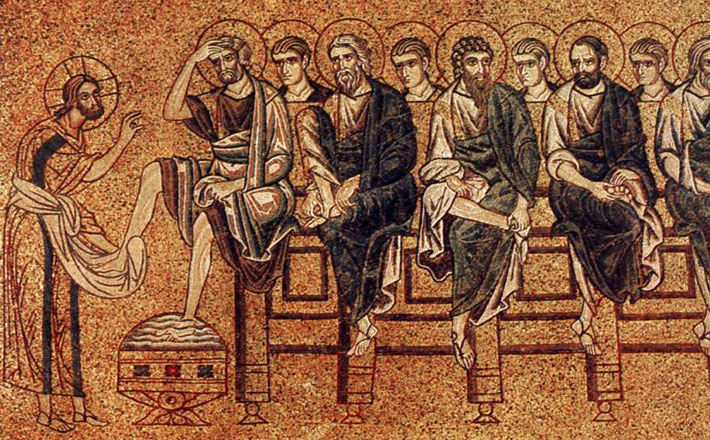Commentary on Luke 22:1-27
The word “maundy” comes from the Latin word for “command.” On this Maundy Thursday, we contemplate Christ’s two greatest commandments: to love God and love your neighbor as yourself (Luke 10:26-28; see also Matthew 22:38-39). Love for God and neighbor will be a through-line in the commentaries for Easter week.
At Luke 22:1, Jesus’ story takes a dramatic turn. Previously, Jesus met with a wide variety of folks while journeying to Jerusalem, teaching and healing along the way. Now, such encounters cease. Impending doom casts a dark pall over the story, as the narration narrows in on Jesus’ upcoming execution.
There are many rich themes in Luke 22 on which preachers might focus, including:
- Passover traditions, ritual, the institution of the Lord’s Supper as a form of eucharistic remembrance
- Embodiment and Jesus’ willing sacrifice
- Hospitality, as illustrated by the procurement of the Upper Room
This essay focuses on one issue that I hope preachers will consider and address carefully: the vexed question of who is responsible for Jesus’ death. One of the most spectacular failures in the history of the Church has been Christians’ failure to love the Jewish people as ourselves.
Historically, it was a Roman practice to execute criminals via crucifixion. Yet, Christians have blamed the Jews for Jesus’ crucifixion for centuries, beginning in the New Testament texts themselves. Most explicit is the so-called blood curse in Matthew 27:25 (Then the people as a whole answered, “His blood be on us and on our children!”). Luke’s narrative also names the Jews as culpable for Jesus’ death. In today’s passage, Luke 22:2 identifies the “chief priests and scribes” as “looking for a way” to kill Jesus. Immediately after, Satan enters into Judas (verse 3; the “opportune time” foreseen in Luke 4:13) and the chief priests and temple police officers rejoice as they collaborate with Judas to betray Jesus (verses 4-5). Throughout Luke, Jews are portrayed as hypocritical, legalistic (believing in works-based salvation, not divine grace), exclusivist, and self-serving (for example, Luke 5:17, 21, 30, 33: 6:2, 7; 7:30, 36; 11:39-53; 12:1; 14:1-3; 15:2; 16:14; 17:20; 19:39; 20:27). Such passages have contributed to a long legacy of Christian anti-Semitism.
Christian preachers in a post-Holocaust world are ethically responsible for addressing and lamenting this pernicious plotline, partly because many Christians today do not realize the extent to which Gospel texts fueled the Nazis’ hatred of the Jews, but also because certain retellings of Jesus’ story from the pulpit continue to legitimize anti-Semitism today, often in subtle and unacknowledged ways. This is not merely a past problem or a theoretical exercise. Christian storytelling habits have real-world effects; hate crimes against Jewish people in the U.S. are increasing. Christian preachers cannot ignore the hatred and violence that have arisen from these “texts of terror.”
How should preachers handle these texts?
Here are several options, each of which has limitations:
Option one: Some advocate cutting anti-Jewish texts out of the lectionary, much like Thomas Jefferson purportedly took scissors and literally cut out the passages he found unacceptable. Instead, one might focus on the positive depictions of Jews in the Gospels. Jews are not only antagonists in the Gospel of Luke. The protagonists—Jesus and his apostles—were themselves Jewish. The Third Gospel shows Jesus dining and collaborating with Pharisees (for example 7:36; 11:37; 13:31), and Luke’s second volume, the Acts of the Apostles, shows Pharisees and Jewish priests being tolerant (for example, 5:34-39; 6:7). The Lukan portrayal of the Jews is not monolithic; one could choose only to preach on the positive passages. The difficult questions here include: How would it impact the story to excise all negative mentions of the Jews? How should we decide what exactly to cut out and what to emphasize? Who should have the authority to make such decisions?
Option two: Others locate the texts within a specific historical context and argue that the references to Jews do not apply beyond that time period; the early Christians condemned the Jews because they had been rejected by the Jews and kicked out of their synagogues. However, this shifts the blame back onto the Jews, essentially saying that they deserve to be portrayed viciously because they were vicious to Christians first.
Option three: Many take an allegorical approach, seeing the “Jews” as all who reject Jesus. Similarly, Christians have treated the “Jews” as symbols of vices like greed or hypocrisy for centuries. For example, the fifth-century Bible translator Jerome called prideful Christians “scribes and Pharisees,” while Protestant Reformer Martin Luther called Catholics “Pharisees” for trusting in works-based salvation.
In this line of thinking, it hardly matters that Luke names Jews. They could be “aliens from Mars” and they would function the same way in the story: they are simply unbelievers. The problem here is that they are not imaginary characters. The references are connected with an actual group of people whose ancestors are impacted by these portrayals. Furthermore, using “Jews” to denounce perceived sins or deficiencies is not much better than condemning the Jews themselves.
Option four: Personally, I see the negative references to the Jews as indicative of early Christian efforts to form a new identity. This does not excuse the Gospels’ vitriol against the Jews, but it does explain it. Early Christian condemnations of the Jews represent attempts to create a separate identity. Sociologists call this “otherizing.” The crucial aspect of “otherizing” is that the more similar we are to the “others,” the more vehemently and polemically we work to draw distinctions between “us” and “them.” Still, this fourth approach runs the risk of too easily dismissing Christian anti-Judaism.
Whatever approach the preacher takes, we might all do well to invite our congregants to repent and lament the “otherizing” atrocities that have been committed—that we continue to commit—in God’s name. On Maundy Thursday, may we ask ourselves: How are we failing to fulfill Christ’s commandments by perpetuating anti-Jewishness? How can we honor Christ’s suffering by living and loving in community as he did—as “one who serves” (verse 27)?
PRAYER OF THE DAY
Divine Servant,
You gave up all the power of the universe to serve humanity in the body of one who would endure great suffering. By your ultimate sacrifice you taught us how to serve. Make us grateful servants of the people of the earth, and feed our souls with your holy meal, for the sake of the one who held back nothing to give us everything, Jesus Christ our savior. Amen.
HYMNS
Go to dark Gethsemane ELW 347, H82 171, UMH 290, NCH 219
Stay with me ELW 348
Here is bread ELW 483
For the bread which you have broken ELW 494, H82 340, 341, UMH 615
CHORAL
We shall walk through the valley, Undine Smith Moore


April 1, 2021